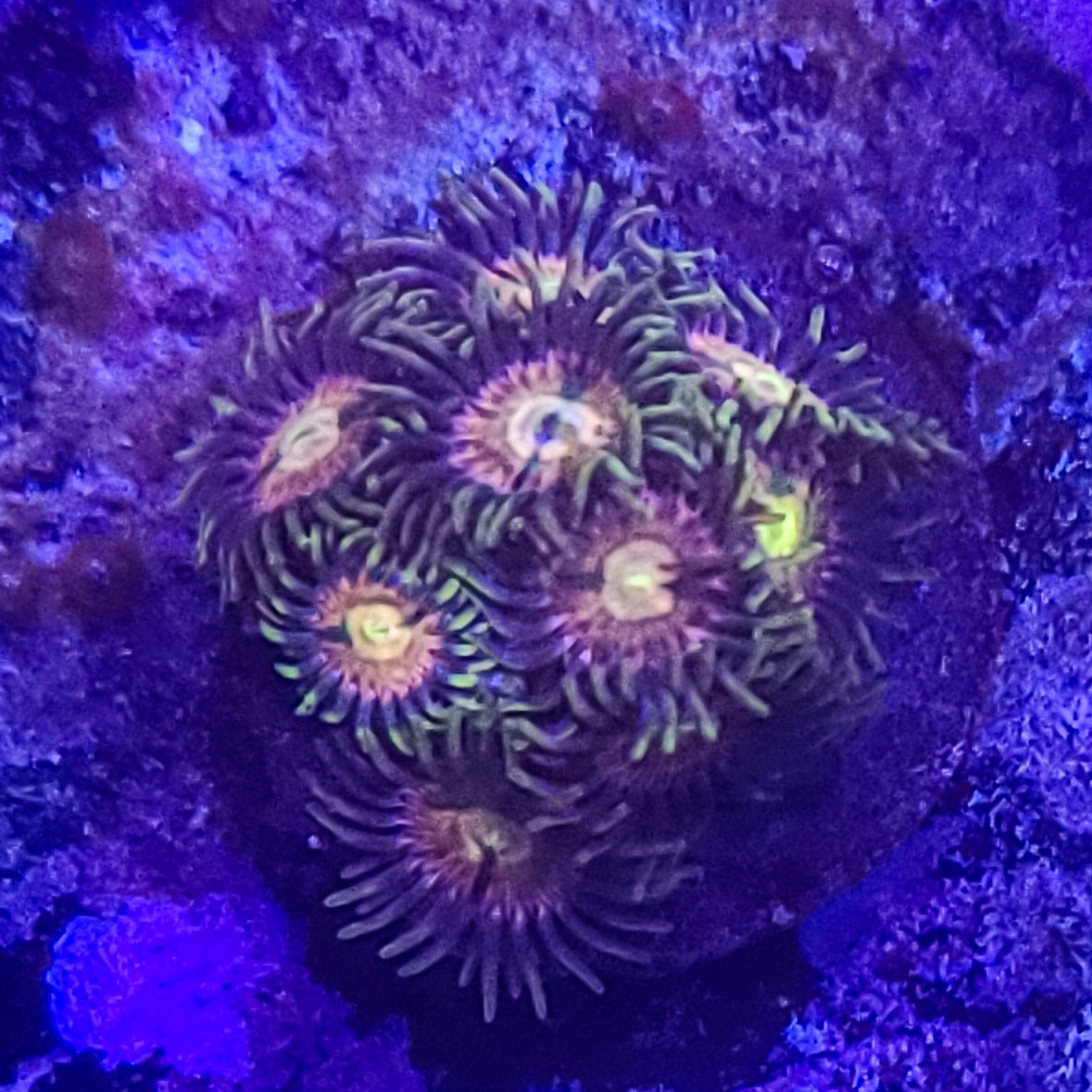
Description
Review
FAQ
This is a picture of the exact piece of coral you will receive (WYSISWYG).
Zoanthids, or Zoas, refer to the soft coral that look like small colorful flowers. They are colonizing, fast growing, easy to care for and are, arguable, one of the most popular corals. Unlike many other corals, Zoas are peaceful and don’t sting other surrounding coral.
One fun and visually interesting thing to do is to “plant” a Zoa garden as they can be placed directly next to other Zoas and coral without difficulty. With so many available vibrant colors, Zoas can make quite a display.
Many Zoas, under reasonable conditions, can grow quite quickly, although it varies by strain. They can be placed on rocks and allowed to spread out – and you can move the rocks as desired. Because Zoas are quite adaptable in terms of light, nutrients and water flow. Zoas are soft coral and don’t require calcium to calcify and create skeleton structures like most other coral. They do well in low nutrient tanks, but adapt to most conditions.
TIPS: Here are some tips for caring for Zoas:
Water Parameters: Zoas need stable water conditions to thrive. Ideal parameters include:
· Temperature: 72–78°F (22–26°C)
· pH: 8.1–8.4
· Salinity: 1.023–1.025
· Alkalinity: 8–10 dKH
· Nitrates: <15 ppm
· Phosphates: <0.10 ppm
· Calcium: 420–440 ppm
· Magnesium: 1260–1350 ppm
Light: Pretty adaptable, but generally moderate to high (but don’t overdo at the high end as they may bleach).
Water Flow: Zoas can do well under low water flow, but moderate flow is recommended. Zoas can tolerate high flow if indirect. If in faster water flow, make sure that the heads are still opening. A wave maker can be a good choice with Zoas as most wave makers can provide moderate, indirect and random flow. The flow helps keep their bodies clear of detritus (squeezing water into an established colony can also help avoid detritus build up). Adequate flow also allows food to continually pass over their heads.
Location: Place Zoas in an area of the aquarium that receives enough light and water flow, often near the middle (to lower part) of the tank. Zoas can tolerate both high and low light conditions, but too much light can cause them to bleach and lose color, while too little light can cause them to brown out and stretch.
Maintenance: Monitor water parameters regularly and perform regular water changes. You can also squirt water at the base of the colony regularly to dislodge buildup, but only do this with well attached and established colonies.
Feeding: Zoas generally don’t need to be fed as they are photosynthetic coral getting most of their nutrition from their symbiotic zooxanthellae. However, they do like to eat and can be fed a variety of different foods. Feeding them increases their color, growth speed and overall health. The larger strains with larger heads will accept meaty foods, including frozen brine shrimp (put small amounts on the heads and it will absorb it). Zoas with smaller heads are unable to consume larger pieces and will rely on smaller particle foods.
Supplements: Zoas like iodine. Water changes will generally replenish the needed iodine, but limited supplemental iodine may be beneficial. Reef Roids are also a good supplement.
Propagation and Toxicity. Zoas are fun and easy to propagate. Some strains, although not all, contain palytoxin (can’t tell which is which). So, you need to handle Zoas with some care. Always use gloves and eye protection when fragging Zoas.
Description
This is a picture of the exact piece of coral you will receive (WYSISWYG).
Zoanthids, or Zoas, refer to the soft coral that look like small colorful flowers. They are colonizing, fast growing, easy to care for and are, arguable, one of the most popular corals. Unlike many other corals, Zoas are peaceful and don’t sting other surrounding coral.
One fun and visually interesting thing to do is to “plant” a Zoa garden as they can be placed directly next to other Zoas and coral without difficulty. With so many available vibrant colors, Zoas can make quite a display.
Many Zoas, under reasonable conditions, can grow quite quickly, although it varies by strain. They can be placed on rocks and allowed to spread out – and you can move the rocks as desired. Because Zoas are quite adaptable in terms of light, nutrients and water flow. Zoas are soft coral and don’t require calcium to calcify and create skeleton structures like most other coral. They do well in low nutrient tanks, but adapt to most conditions.
TIPS: Here are some tips for caring for Zoas:
Water Parameters: Zoas need stable water conditions to thrive. Ideal parameters include:
· Temperature: 72–78°F (22–26°C)
· pH: 8.1–8.4
· Salinity: 1.023–1.025
· Alkalinity: 8–10 dKH
· Nitrates: <15 ppm
· Phosphates: <0.10 ppm
· Calcium: 420–440 ppm
· Magnesium: 1260–1350 ppm
Light: Pretty adaptable, but generally moderate to high (but don’t overdo at the high end as they may bleach).
Water Flow: Zoas can do well under low water flow, but moderate flow is recommended. Zoas can tolerate high flow if indirect. If in faster water flow, make sure that the heads are still opening. A wave maker can be a good choice with Zoas as most wave makers can provide moderate, indirect and random flow. The flow helps keep their bodies clear of detritus (squeezing water into an established colony can also help avoid detritus build up). Adequate flow also allows food to continually pass over their heads.
Location: Place Zoas in an area of the aquarium that receives enough light and water flow, often near the middle (to lower part) of the tank. Zoas can tolerate both high and low light conditions, but too much light can cause them to bleach and lose color, while too little light can cause them to brown out and stretch.
Maintenance: Monitor water parameters regularly and perform regular water changes. You can also squirt water at the base of the colony regularly to dislodge buildup, but only do this with well attached and established colonies.
Feeding: Zoas generally don’t need to be fed as they are photosynthetic coral getting most of their nutrition from their symbiotic zooxanthellae. However, they do like to eat and can be fed a variety of different foods. Feeding them increases their color, growth speed and overall health. The larger strains with larger heads will accept meaty foods, including frozen brine shrimp (put small amounts on the heads and it will absorb it). Zoas with smaller heads are unable to consume larger pieces and will rely on smaller particle foods.
Supplements: Zoas like iodine. Water changes will generally replenish the needed iodine, but limited supplemental iodine may be beneficial. Reef Roids are also a good supplement.
Propagation and Toxicity. Zoas are fun and easy to propagate. Some strains, although not all, contain palytoxin (can’t tell which is which). So, you need to handle Zoas with some care. Always use gloves and eye protection when fragging Zoas.
Review
FAQ

